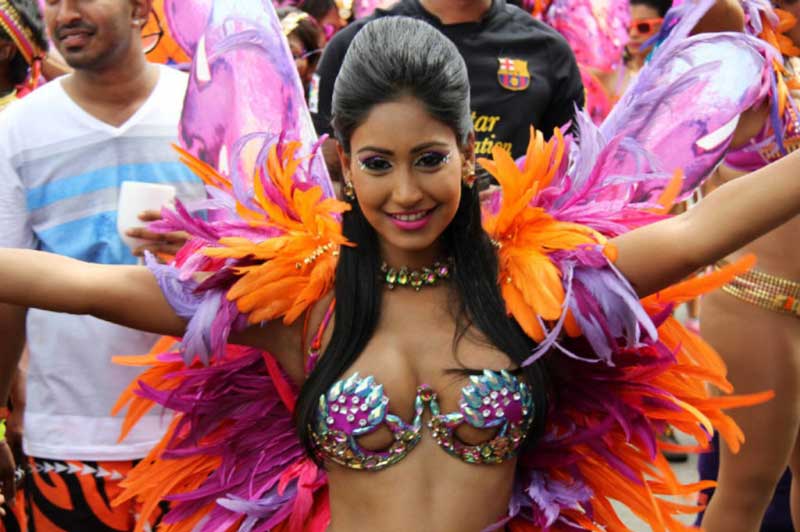
The fascinating and colourful Trinidad and Tobago Carnival has a long history, which dates back to the days when slavery was still widespread. The tradition of masquerades and balls started in Trinidad and Tobago in the late 18th century by the French plantation owners before enduring the fasting of Lent. But, the slaves were not allowed to take part in the Carnival and attending the fancy parties and balls, arranged by their masters. Nevertheless, soon they organized a parallel celebration of their own by designing elaborate costumes, named it Canboulay and started to celebrate it in their quarters.
The name Canboulay is originated from the French ‘cannes brulées’, meaning ‘burnt cane’, and this new celebration is supposed to be the predecessor of the Trinidad and Tobago Carnival. It has also played a very important role in the evolution, modification and betterment of the music of Trinidad and Tobago. Calypso music was developed in Trinidad in the 17th century from the West African Kaisoand, while Canboualy music was imported to the Caribbean Islands by the African slaves, who used to work on the sugar plantations. They used calypso to communicate with each other and to mock their white masters.

In fact, Trinidad and Tobago is multicultural, consisting of Amerindian, European, African, Indian, Chinese and Middle Eastern cultures. All these cultures have merged together here to create a new type of music, which is very much different from that of the Carnival in Spain, Venice or New Orleans and all of its groups have contributed their musical influences to the sounds of the Carnival.


Following Emancipation, the former slaves started to celebrate their own event as an open public carnival and two centuries later, the carnival has evolved into an extravagant, billion-dollar event for Trinidad and Tobago. The carnival, an annual event, held on the Monday and Tuesday before Ash Wednesday in Trinidad and Tobago, is widely known for the colourful costumes of the participants and the exuberant celebrations. Today, apart from Trinidad and Tobago, the Carnival is also celebrated in many other cities throughout the world.
The Trinidad and Tobago Carnival, popularly known as the Mardi Gras of the Caribbean, is celebrated each February in Port-of-Spain, the capital of Trinidad & Tobago. Traditionally, the festival is closely associated with calypso music, which was originated and formulated in the midst of hardship of the enslaved West and Central Africans. But, following the demand of the day, now it is replaced by the Soca music. Colourful costumes, stick-fighting and limbo dance competitions are also important parts of the festival.
Limbo is popularly considered as the national dance of Trinidad and Tobago. However, stick-fighting and the African percussion music were banned in 1881 and were replaced by Tamboo Bamboo, a Caribbean percussion instrument, which was also banned in turn. Ultimately, they appeared again in 1937, in a transformed form as an orchestra of beating the frying pans, dustbin lids and oil drums. Known as 'steelpans', this is now a popular section of the canboulay music contests.



The opening event of the carnival, known as J’ouvert, starts with a bang in the early hours of Monday, when people in loaded trucks with thundering music rush towards the streets, dance as if in a trance, and finally starts to throw mud, oil, and paint at each other madly. This is an incredible opportunity for the participants to lose all their age old inhibitions and express their inner self, which will be stored in their memories for a pretty long time. However, though Monday is an enteric and vibrant day of the carnival, it is only the warm-up for the grand finale on the next day.



The crazy excitement of Tuesday also begins as early as 8 in the morning, when the merrymakers in full costume dance along the streets with the variety of bands on show. Each band has their theme according to the culture of the land. From early morning the bands gather their masqueraders at selected meeting points and make their way to the main stages to parade in front of the world. The Band of the Year title is judged by panels at various locations around the city. Known as ‘Parade’, this is the most important part of the Carnival, where anybody and everybody, even the children can join. Each parade is led by an elaborately costumed King and a Queen, who are chosen on Carnival Sunday. For the smooth proceeding of the parades, guards are engaged to hold ropes on each side of the street to separate the participants from the interested onlookers. However, very often persons manage to get inside the parading arena to take a few shots of the dancing beauties adorned in their dazzling costumes, or join the march for a few minutes with them. Vehicles are also arranged, where bartenders pour alcoholic and non-alcoholic beverages into cups for any participant or follower of the parade.



With its spectacular costumes, crazy dance and pulsating music, the Trinidad and Tobago Carnival can be rightly defined as one among the greatest shows on the earth. It is probably the country’s cultural highlight and premier tourist attraction. It is wild and hot, crazy and colourful. It is refreshingly free from all types of inhibitions, taboos and it breaks all the shackles of the imposed social restrictions.